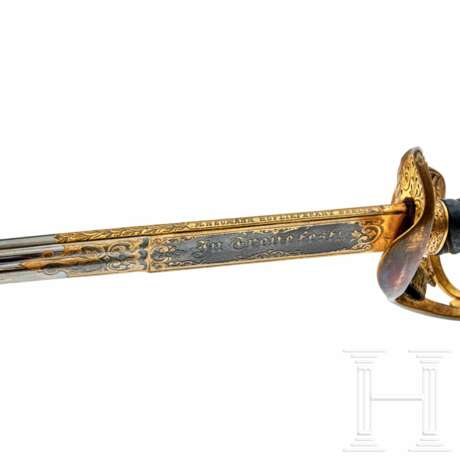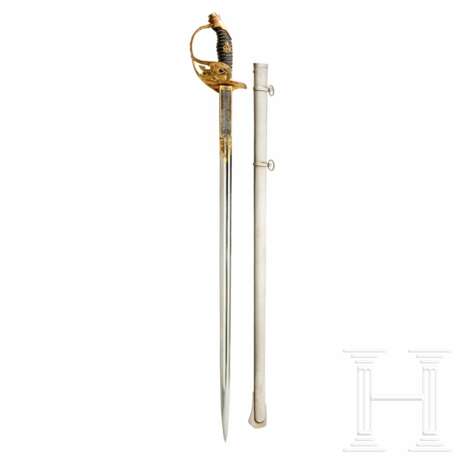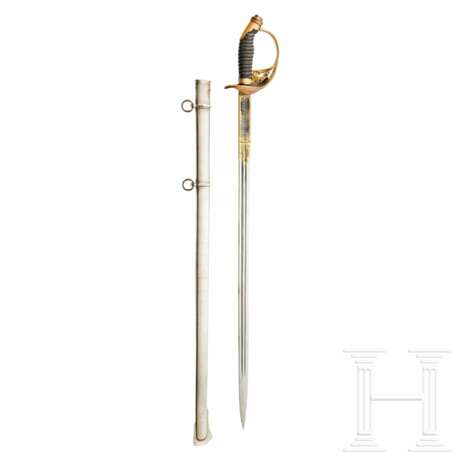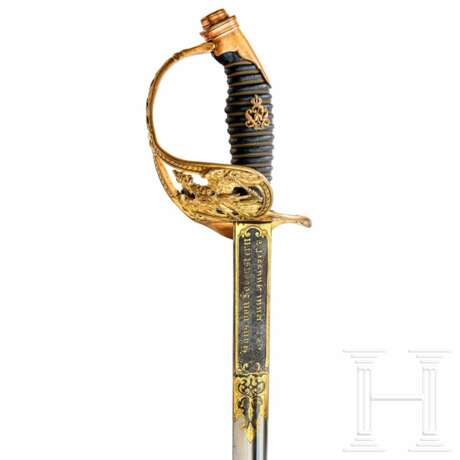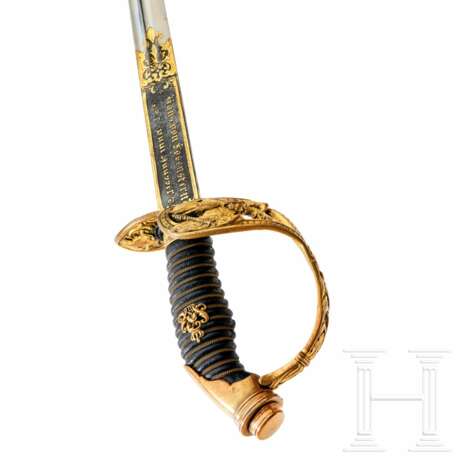ID 1414436
Lot 1821 | SS-Oberst-Gruppenführer Paul Hausser - IOD 89 mit Klingenätzung
Beidseitig vergoldete Klingenätzung mit gebläutem Hintergrund, eine Seite zeigt die Inschrift "IN TREUE FEST", die andere Seite mit dem Namen des Schenkenden und des Empfängers "Hans von Sodenstern an Paul Hausser", am Klingenrücken der Name des Lieferanten "M. Neumann Hoflieferant Berlin". Vergoldetes Messinggefäß mit preußischem Adler, Rochenhautgriff mit intakter Drahtumwicklung und preußischer Chiffre. Vernickelte Scheide mit zwei Ringen, Gesamtlänge ca. 100 cm.
Hans von Sodenstern und Paul Hausser waren bei Kadetten im Selekta-Kurs 1899 an der Hauptkadettenanstalt in Berlin-Lichterfelde. Sie hatten lange Karrieren in der Infanterie von 1899 bis zum Ersten Weltkrieg. Paul Hausser (1880 - 1972), nach dem Krieg auch unter seinem Geburtsnamen als Paul Falk bekannt, war ein deutscher General und später hochrangiger Kommandeur der Waffen-SS. Er spielte eine zentrale Rolle in den Bemühungen ehemaliger Mitglieder der Waffen-SS, nach dem Krieg eine historische und rechtliche Rehabilitation zu erreichen. Hausser diente als Offizier im preußischen Heer während des Ersten Weltkriegs und erreichte in der Zwischenkriegszeit den Rang eines Generals im Reichsheer. Nach seiner Pensionierung trat er der SS bei und war maßgeblich an der Aufstellung der Waffen-SS beteiligt. Im Zweiten Weltkrieg stieg er zum Oberbefehlshaber einer Heeresgruppe auf und führte Waffen-SS-Truppen in der Dritten Schlacht von Charkow, der Schlacht bei Kursk und in der Normandie an. Hausser war neben Sepp Dietrich einer der ranghöchsten Offiziere der Waffen-SS. Im Gegensatz zu Dietrich war Hausser bereits ein ausgebildeter Generalstabsoffizier, bevor er der SS beitrat. Nach dem Krieg wurde er Gründungsmitglied und erster Sprecher der HIAG, einer Lobbygruppe und revisionistischen Veteranenorganisation, die 1951 von ehemaligen hochrangigen Angehörigen der Waffen-SS in Westdeutschland gegründet wurde. Die HIAG setzte sich für die Wiederherstellung der rechtlichen und wirtschaftlichen Stellung der Waffen-SS ein und verfolgte das Ziel einer vielschichtigen Propagandakampagne.
USA-Los – weitere Infos hier
SS-Oberst-Gruppenführer Paul Hausser - an etched presentation officer's sword
SS-Oberst-Gruppenführer Paul Hausser - an etched presentation officer's sword
Etched gilt deluxe model IOD 89 officer, handle wire-wrapped black ray skin grip with gilted brass Prussian cypher, gilt Prussian eagle cross guard, engraved front blue panel with names of presenter and receiver in gold (Hans von Sodenstern to Paul Hausser). Both were cadets at the Berlin-Lichterfelde 1899 Selekta course at the Hauptkadettenanstalt. Both had long careers in the infantry from 1899 through WWI, back-blued panel with gold friendship inscription. Bright plain silver blade, straight silver two-ring scabbard. Length ca. 100 cm.
Paul Hausser, also known as Paul Falk after taking his birth name post-war (7 October 1880 – 21 December 1972), was a German general and then a high-ranking commander in the Waffen SS who played a key role in the post-war efforts by former members of the Waffen SS to achieve historical and legal rehabilitation. Hausser served as an officer in the Prussian Army during World War I and attained the rank of general in the interwar Reichsheer. After retirement, he joined the SS and was instrumental in forming the Waffen-SS. During World War II, he rose to the level of army group commander. He led Waffen-SS troops in the Third Battle of Kharkov, the Battle of Kursk, and the Normandy Campaign. Hausser was the highest-ranking officer in the Waffen SS alongside Sepp Dietrich. Unlike Dietrich, Hausser was a trained staff officer before joining the SS. After the war, he became a founding member and the first spokesperson of HIAG, a lobby group and a revisionist veterans' organization, founded by former high-ranking Waffen SS personnel in West Germany in 1951. It campaigned for the restoration of the legal and economic rights of the Waffen SS, employing a multi-pronged propaganda campaign to achieve its aims.
USA lot - more info here
Condition: II
| Auction house category: | Waffen-SS and general SS |
|---|
| Auction house category: | Waffen-SS and general SS |
|---|
| Address of auction |
Hermann Historica Bretonischer Ring 3 85630 Grasbrunn / München Germany | ||||||||||||||
|---|---|---|---|---|---|---|---|---|---|---|---|---|---|---|---|
| Preview | |||||||||||||||
| Phone | +49 (0)89 5472 649 0 | ||||||||||||||
| Fax | +49 (0)89 5472 64999 | ||||||||||||||
| Buyer Premium | 25 % | ||||||||||||||
| Conditions of purchase | Conditions of purchase | ||||||||||||||
| Business hours | Business hours
|

